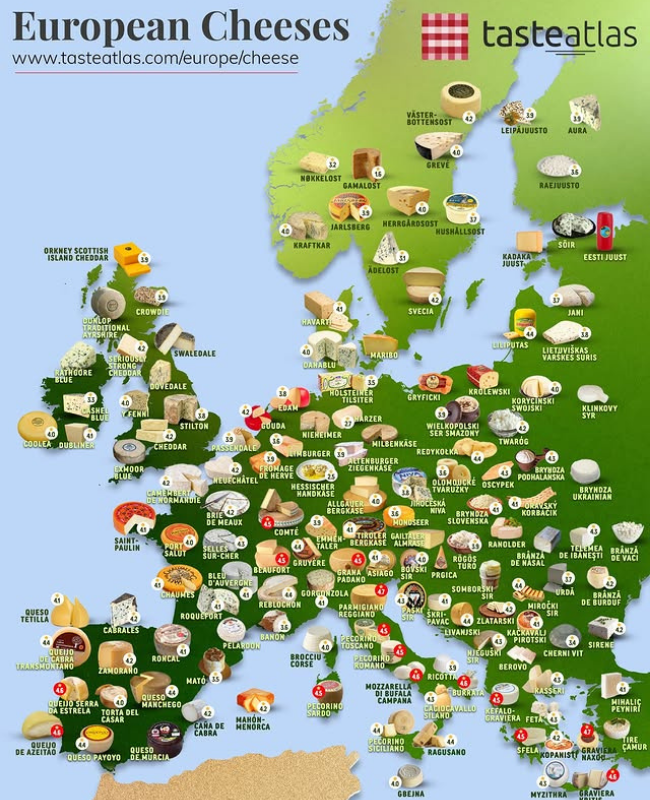European Cheese Varieties Map


David Chen
Data Visualization Specialist
David Chen is an expert in transforming complex geographic datasets into compelling visual narratives. He combines his background in computer science ...
Geographic Analysis
What This Map Shows
The "Fancy Some Cheese – A Map of European Cheeses" visualization displays the diverse range of cheese varieties produced across various countries in Europe. It highlights the geographic distribution of these cheeses, each tied closely to its region of origin, showcasing the rich culinary heritage that defines European gastronomy. This mapping of cheese types not only serves as a feast for the eyes but also opens a window into the cultural identity and agricultural practices behind these delicious products.
Deep Dive into European Cheeses
Cheese is more than just a food item in Europe; it's an integral part of cultural history, tradition, and even local economies. With over 1,800 distinct varieties, European cheeses vary significantly in taste, texture, and production method, reflecting the unique terroir of each region. For instance, the rich pastures of France are home to renowned cheeses like Brie and Roquefort, while the mountains of Switzerland produce the world-famous Gruyère.
Interestingly, the diversity of cheese is influenced by several factors, including the type of milk used (cow, goat, sheep), the methods of production, and the aging process. For example, cheeses like Parmigiano-Reggiano from Italy are made from cow's milk and aged for a minimum of 12 months, developing a complex flavor profile that is unmatched. In contrast, fresh cheeses such as Ricotta are consumed almost immediately after production, offering a creamy texture and a milder taste.
In addition to taste, the production of cheese is deeply tied to local traditions and agricultural practices. Many regions have specific laws governing the production of their cheeses, such as the AOC (Appellation d'Origine Contrôlée) in France, which ensures that certain cheeses can only be made in designated areas and according to traditional methods. This emphasis on local production not only preserves the cultural significance of these cheeses but also supports local economies.
Moreover, cheese plays a role in European social customs. From cheese boards at social gatherings to its inclusion in national dishes, cheese is often the centerpiece of culinary experiences, inviting people to share and enjoy. The concept of "terroir"—the idea that the environment affects the taste of food—is particularly pronounced in cheese production, leading to a deep appreciation for local varieties.
Regional Analysis
Let's take a closer look at specific regions in Europe and their cheese specialties. In France, the Normandy region is famous for Camembert, a soft cheese with a creamy interior and a bloomy rind. Moving south, the Provence region offers Feta, a brined cheese that is integral to Mediterranean cuisine. On the other hand, Italy’s northern regions are known for Gorgonzola, a blue cheese that presents a sharp, tangy flavor, while Southern Italy boasts Mozzarella, a fresh cheese that has become a staple worldwide.
In the UK, Cheddar cheese from Somerset is one of the most recognized varieties globally. Interestingly, the cheese has a rich history dating back to at least the 12th century. In contrast, the Netherlands is renowned for Gouda, a cheese that can be aged to develop complex flavors, proving that the Dutch have mastered both young and aged cheese varieties.
The diversity doesn’t stop there; Spain offers Manchego, a sheep's milk cheese famed for its nutty flavor, while Greece remains synonymous with Feta, a cheese that has become a symbol of Mediterranean health and cuisine. Each of these cheeses tells a story about its origin, the land, and the people who produce it.
Significance and Impact
Understanding the geographic distribution of cheeses in Europe is not merely an exploration of culinary delights; it also carries significant implications for agricultural practices, tourism, and cultural exchanges. Cheese tourism is a growing trend, with enthusiasts traveling across Europe to experience local cheese-making traditions. This trend not only boosts local economies but also fosters appreciation for cultural heritage.
Moreover, with the increasing importance of sustainable agriculture, many cheese producers are adopting eco-friendly practices, thus impacting the environment positively. Supporting local cheesemakers helps preserve biodiversity and promotes sustainable farming methods. As consumers become more mindful of their food choices, the interest in local cheeses is likely to grow, paving the way for new cheese varieties and innovative production methods.
In conclusion, the map of European cheeses is a testament to the rich tapestry of culinary traditions across the continent. By understanding the nuances of these cheeses, we can appreciate the interconnectedness of geography, culture, and gastronomy in shaping our world.
Visualization Details
- Published
- October 28, 2025
- Views
- 6
Comments
Loading comments...